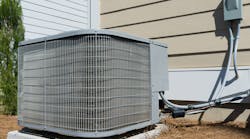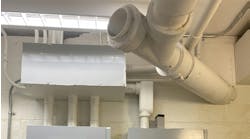The National Fire Protection Association (NFPA) recently issued two Tentative Interim Amendments (TIAs) to the 2020 edition of NFPA 70, National Electrical Code. Open for comments until July 19, TIA Log No. 1589 (which was submitted by Dan Buuck, National Association Home Builders, and Clayton Traylor, Leading Builders of America) and TIA Log No 1593 (submitted by Dean Hunter, Minnesota Department of Labor & Industry) both seek to revise Section 210.8(F). Anyone can submit a comment here.
TIA Log 1589
1. Revise Section 210.8(F) to read as follows:
210.8 Ground-Fault Circuit-Interrupter Protection for Personnel. ...(F) Outdoor Outlets. All outdoor outlets for dwellings, other than those covered in 210.8(A)(3), Exception to (3), that are supplied by single-phase branch circuits rated 150V to ground or less, 50A or less, shall have ground-fault circuit-interrupter protection for personnel. This requirement shall become effective January 1, 2023, for heating/ventilating/air-conditioning (HVAC) equipment.
Substantiation: GFCI protection was expanded in the 2020 NEC without HVAC component and equipment safety standards being harmonized with GFCI amperage limits. Currently, the UL standard that HVAC equipment is listed to (UL 1995) has no requirements for leakage current if the unit is hard wired, as most residential air conditioners/heat pumps are. In the future, HVAC equipment will be listed to UL 60335-2-40, which sets a limit of 10 milliamps of leakage current. However, this new standard is not mandatory until 1/1/2024. UL 943 is the standard to which GFCI breakers are listed and are required to trip at 5 milliamps of current. Even if HVAC equipment is listed to the UL 60335-2-40 standard, there is no guarantee it will be compatible with UL listed GFCI breakers This lack of coordination is what is leading to the nuisance tripping that customers are dealing with.
Until both equipment and component standards are updated, designers, installers, AHJs, and consumers are forced to choose between an NEC 2020 compliant installation or an operational installation. In jurisdictions that have adopted 2020 NEC with 210.8(F) intact, there have been numerous instances of field tripping of the GFCI breaker on ductless mini splits, units containing power conversion equipment, and on many single-stage units.
In his negative ballot on Second Revision 7676 (NFPA 70-2018) Mark Hilbert noted “it is unknown if AC units will operate on a GFCI-protected circuit as sufficient testing has not been conducted to answer this question. What if the AC unit is in an area where there is high humidity and hot conditions and the GFCI trips when the owners are not present for extended periods of time? This can result in interior property damage and unhealthy conditions from mold, etc.” Several of the negative ballots, including Mr. Hilbert’s, also noted that the reported incidents that were the basis for the new requirement were a set of very specific unfortunate circumstances that might not be prevented had GFCI protection been installed.
The effects of this new requirement in the 2020 edition of the Code has come to light over the past one to two weeks with the first hot/humid weather in Texas. Leading Builders of America (LBA) has collected the following data over the past couple days.
- Builder A has indicated a 73% failure rate (GFCI breaker tripping) for non-mini-split, non-variable speed systems. In other words, 100% of Builder A’s failures are on single-speed conventional cooling systems.
- Builder B has 36 homes where the HVAC system is operational. 100% of those homes have experienced a circuit trip. All of Builder B’s failures are on single-stage systems. They currently have 10 open warranty tickets for closed (occupied) units where the circuit is tripping consistently, leaving the homeowners with effectively no HVAC.
TIA No. 1564 was recently balloted and was unable to pass on both the technical merit and emergency nature. Some of the negative ballots suggested that the language proposed had issues that could create confusion for compliance and enforcement. Those language issues have been addressed in this proposed TIA. Some negative ballots also suggested limiting the application to power conversion technology. Unfortunately, recent incident experience has indicated that the problem is more widespread. It should be abundantly clear that the proposed change in this TIA has both technical merit and is desperately needed at this time. Being at the beginning of the heating season, we have only seen the tip of the iceberg of the problems that this TIA can solve.
Emergency Nature: The proposed TIA intends to correct a circumstance in which the revised NFPA Standard has resulted in an adverse impact on a product or method that was inadvertently overlooked in the total revision process or was without adequate technical (safety) justification for the action.
The 2020 CDC report Heat-Related Deaths – United States, 2004-2018 (https://www.cdc.gov/mmwr/volumes/69/wr/pdfs/mm6924a1-H.pdf) states, “During 2004–2018, an average of 702 heat-related deaths occurred in the United States annually.” The report states the following on p732, “Past studies have demonstrated a relationship between ambient temperatures and mortality (8). In particular, extreme heat exposure can exacerbate certain chronic medical conditions, including hypertension and heart disease (4,5). In addition, medications that are typically used to treat these chronic medical conditions such as beta-blockers, diuretics, and calcium-channel blockers, can interfere with thermoregulation and result in a reduced ability to respond to heat stress (5).” [Emphasis added]. These statistics are significant and if this code conflict is not corrected, will increase this summer.
It is clear that the tripping of the breakers constitutes a dire safety issue for all new construction in hot regions where electrical systems are being installed according to the 2020 edition of the NEC. Without this TIA, designers, installers, AHJs, and consumers are forced to choose between a compliant or an operational installation. This incompatibility is happening in a very large number of installations and is causing extreme economic duress for those involved to resolve these issues as well as for new homeowners, who must keep resetting the breaker to maintain healthy humidity and temperature levels in the home.
Anyone may submit a comment by the July 19, 2021, closing date indicated above. Please identify the TIA number and forward to the Secretary, Standards Council. SUBMIT A COMMENT
TIA Log No. 1593
1. Revise 210.8(F) to read as follows:
210.8 Ground-Fault Circuit-Interrupter Protection for Personnel. ... (F) Outdoor Outlets. All outdoor outlets for dwellings, other than those covered in 210.8 (A)(3), Exception to (3), that are supplied by single-phase branch circuits rated 150V to ground or less, 50A or less, shall have ground-fault circuit-interrupter protection for personnel. This requirement shall become effective on January 1, 2023, for mini-split-type heating/ventilating/air-conditioning (HVAC) equipment and other HVAC units employing power conversion equipment as a means to control compressor speed.
Informational Note: Power conversion equipment is the term used to describe the components used in HVAC equipment that is commonly referred to as a variable speed drive. The use of power conversion equipment to control compressor speed differs from multistage compressor speed control.
Exception: Ground-fault circuit-interrupter protection shall not be required on lighting outlets other than those covered in 210.8(C).
Substantiation: This expansion of GFCI protection in the 2020 NEC, for the purpose of covering exterior outlets through 250V at dwelling units, is a necessary enhancement for electrical safety. Code Making Panel 2 supported the expansion of GFCI protection to cover these outdoor outlets based on the electrocution of a young boy who came into contact with the energized enclosure of an outdoor HVAC unit.
The purpose of this TIA is not to eliminate the GFCI protection for all HVAC outdoor equipment, but to extend the date of enforcement for the circuit supplying the HVAC units employing power conversion equipment.
Emergency Nature: The proposed TIA intends to correct a circumstance in which the revised NFPA Standard has resulted in an adverse impact on a product or method that was inadvertently overlooked in the total revision process or was without adequate technical (safety) justification of the action.
In the state of Minnesota, we began enforcing Section 210.8(F) on April 5, 2021, and we have already documented many cases of operational tripping occurrences which have been difficult for inspectors and electricians to resolve. The only solution at this time is for the AHJ to approve a temporary allowance for the installation of a circuit breaker without GFCI protection so that these HVAC units can operate.
The language in this TIA is in direct alignment with the once-proposed TIA 1529 that was supported by Code Making Panel 2 for Technical and Emergency Nature. The Correlating Committee also agreed that no correlating issues existed with this language; however, the TIA narrowly failed ballot with regards to the Emergency Nature. Recently, proposed TIA 1564, which included “all HVAC equipment” failed ballot, but had multiple voting member comments supporting the language in TIA 1529. Also, TIA 1564 language contains substantiation to support reasons for delaying the date to address the operational GFCI tripping.
As we enter into the peak cooling season in Minnesota and in other states where the 2020 NEC has been adopted, it is expected that this issue will continue to grow and be problematic for the enforcement and installation community. Delaying the implementation date allows for the affected stakeholders to reach a solution to the operational tripping occurrences and provides AHJs with the ability to permit installations of cooling equipment that is essential to the health and safety of residents in warm climates.
Anyone may submit a comment by the closing date indicated above. Please identify the TIA number and forward to the Secretary. SUBMIT A COMMENT



